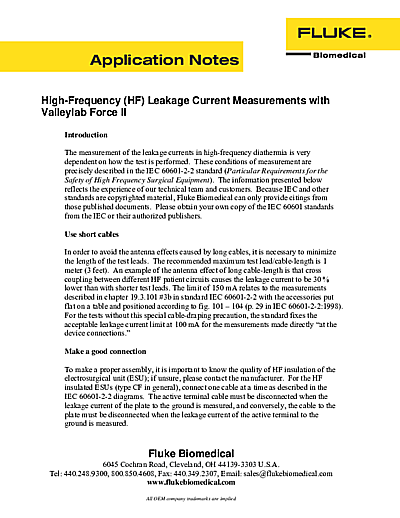High-Frequency (HF) Leakage Current Measurements with Valleylab Force II
Introduction
The measurement of the leakage currents in high-frequency diathermia is very dependent on how the test is performed. These conditions of measurement are precisely described in the IEC 60601-2-2 standard (Particular Requirements for the Safety of High Frequency Surgical Equipment). The information presented below reflects the experience of our technical team and customers. Because IEC and other standards are copyrighted material, Fluke Biomedical can only provide citings from those published documents. Please obtain your own copy of the IEC 60601 standards from the IEC or their authorized publishers.
Use short cables
In order to avoid the antenna effects caused by long cables, it is necessary to minimize the length of the test leads. The recommended maximum test lead/cable-length is 1 meter (3 feet). An example of the antenna effect of long cable-length is that cross coupling between different HF patient circuits causes the leakage current to be 30 % lower than with shorter test leads. The limit of 150 mA relates to the measurements described in chapter 19.3.101 #3b in standard IEC 60601-2-2 with the accessories put flat on a table and positioned according to fig. 101 – 104 (p. 29 in IEC 60601-2-2:1998). For the tests without this special cable-draping precaution, the standard fixes the acceptable leakage current limit at 100 mA for the measurements made directly “at the device connections.”
Make a good connection
To make a proper assembly, it is important to know the quality of HF insulation of the electrosurgical unit (ESU); if unsure, please contact the manufacturer. For the HF insulated ESUs (type CF in general), connect one cable at a time as described in the IEC 60601-2-2 diagrams. The active terminal cable must be disconnected when the leakage current of the plate to the ground is measured, and conversely, the cable to the plate must be disconnected when the leakage current of the active terminal to the ground is measured.
Generating the HF
The internal footswitch of the QA-ES (green or yellow terminals “FOOTSWITCH”) should not be used for the HF leakage currents measurements. The HF must be generated by the pedal specific to the ESU and not by a digitally-controlled relay.
Safety
In order to limit the risk of HF leakage and to improve the conditions of measurement, we recommend maintaining the color-codes of and connector-ends on test leads/cables. Manufacturing test leads/cables using disposable ESU hand-pieces or cables included with the ESU from its manufacturer are not recommended.
Ensure the recommendations for limited test lead/cable-length have been applied and that good connections have been made. While measurements could also be made with an external load and a voltmeter (10 MHz), using an ESU analyzer specifically designed for this testing is highly recommended (e.g. QA-ES from Fluke Biomedical).
